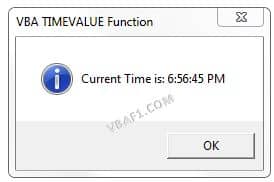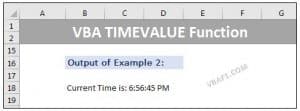VBA TimeValue Function in Excel is a built-in function in MS Excel. It has one input argument or parameter. VBA TimeValue Function returns the time value representing time for a input string value. It is a ‘Data and Time’ type function. TimeValue function can be used in either procedure or function in a VBA editor window in Excel.
We can use the VBA TimeValue Function any number of times in any number of procedures or functions. The following section we learn what is the syntax and parameters of the TimeValue function. We will also learn where we can use this VBA TimeValue Function and real-time examples.
- Objective
- Syntax of VBA TimeValue Function
- Parameters or Arguments
- Where we can apply or use the VBA TimeValue Function?
- Example 1: Convert the given input string to a valid time and display on the screen
- Example 2: Convert the given input string to a valid time and display on the Worksheet
- Download File
- Instructions to Run VBA Macro Code
- Other Useful Resources
VBA TimeValue Function Syntax
The syntax of the VBA TimeValue Function is
TIMEVALUE(time_value)
Parameters or Arguments
There is one parameter or argument for the TimeValue Function in VBA. That is nothing but ‘time_value’ parameter. It is a mandatory argument. It represents time in string format.
Where we can apply or use the VBA TimeValue Function?
We can use this VBA TimeValue Function in MS Office 365, MS Excel 2016, MS Excel 2013, 2011, Excel 2010, Excel 2007 and Excel 2003. We can also use in Excel 2016 for Mac, Excel 2011 for Mac, Excel Online, Excel for iPhone, Excel for iPad, Excel for Android tablets and Excel for Android Mobiles.
Example 1: Convert the given input string to a valid time and display on the screen
Here is a simple example of the TimeValue Function. This below example macro uses the TimeValue Function and displays time for the specified string. In this case specified string represents date.
Sub VBA_TIMEVALUE_Function_Example1()
'Convert the given input string to a valid time and display on the screen
'Variable declaration
Dim CurrentTime As Date
'Assign time to a variable
CurrentTime = TimeValue("18:56:45")
'Display output on the screen
MsgBox "Current Time is: " & CurrentTime, vbInformation, "VBA TIMEVALUE Function"
End Sub
In the above example ‘CurrentTime declared as Date data type. And TIMEVALUE is a vba function. This variable ‘CurrentTime’ now contains the time.
Output: Here is the screenshot of first example output.

Example 2: Convert the given input string to a valid time and display on the Worksheet
Let us see another example of the TimeValue Function. This below example macro uses the TimeValue Function and displays time for the specified string(date). Now, it displays on the Worksheet named ‘VBAF1.Com’ at Range ‘B20’.
Sub VBA_TIMEVALUE_Function_Example2()
'Convert the given input string to a valid time and display on the Worksheet
'Variable declaration
Dim CurrentTime As Date
‘Assign time to a variable
CurrentTime = TimeValue("18:56:45")
'Display output on the screen
Sheets("VBAF1.COM").Range("B20") = "Current Time is: " & CurrentTime
End Sub
Output: Here is the screenshot of second example output.

Download File:
Click on the following link to download free example excel workbook to learn more about the TimeValue Function.
VBA TimeValue Function Examples
Instructions to Run VBA Macro Code or Procedure:
You can refer the following link for the step by step instructions.
Instructions to run VBA Macro Code
Other Useful Resources:
Click on the following links of the useful resources. These helps to learn and gain more knowledge.
VBA Tutorial VBA Functions List VBA Arrays in Excel Blog
VBA Editor Keyboard Shortcut Keys List VBA Interview Questions & Answers
